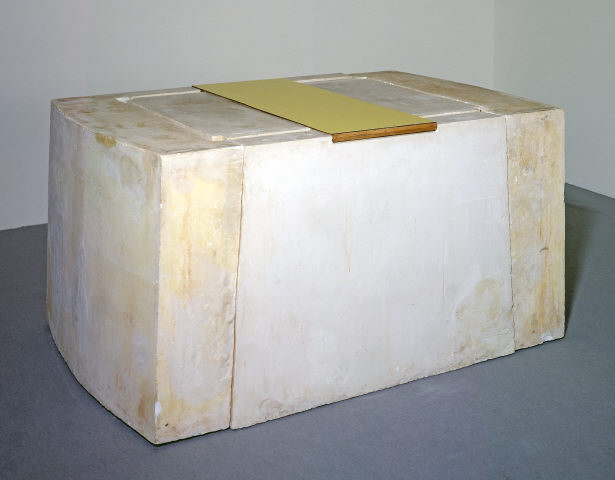
- 1989
- Plaster, Wood and Formica
- Construction
- Inv. 91EE43
Rachel Whiteread
Yellow Leaf
Rachel Whiteread’s sculpture materialises the space underneath a kitchen table, using five plaster elements which, together, form a block with a compact and impenetrable appearance. The title relates to the sheet of formica set into the central element. The other elements, being bound together by this central element, take shelter in it and seal the mould of the empty space. Yellow Leaf was the name of the sheet of formica that served to increase the size of the kitchen table belonging to the artist’s grandmother when friends and family gathered together. The sculpture evokes her childhood memories about (and under) that table, while also celebrating the communal dimension of a shared meal. The sculpture arises from the solidification of a space at which we usually do not look, the space under a table that is in daily use, a non-place that we only reencounter in our memories of gestures, play, and events.
Despite its shareable meaning, in formal terms the sculpture has the hermetic appearance of a small bunker or mastaba. The idea of death, incorporated by the artist as a recurring element from her childhood to her adulthood, pervades all of Whiteread’s work. In her work, not only does the air (which, by definition, is ethereal and ascendant) materialise and acquire weight, but also the familiar and the quotidian take on a strangeness, «the haunted beauty of fossils or photographic negatives».* By moulding the space between, over, or under familiar objects related to the human body – chairs, wardrobes, mattresses, baths, shelves, hot-water bottles – Rachel Whiteread’s sculptures have reinvented this traditional sculptural process, moving it into the foreground, and granting it the protagonism enjoyed by finished works.
She is interested in the materialisation, or tracing, of the memory of the British, middle class objects and spaces among which she grew up, and which, in some sense, bear the imprint of the existence of people who, in the meantime, have disappeared. But although Rachel Whiteread’s work might bear some relation to the refinement of Judd’s or Andres’s minimalist sculptures, with which it shares a basis in architecture and spatial control, her work is marked by the presence of the human, filled with emotions and feelings that are absent from the cold, abstract pieces of the North American artists. Rachel likes the idea of practising a “minimalism with heart”, even if, in the majority of the memories evoked, the heart has stopped beating.
Ana Vasconcelos
May 2010
*Rachel Whiteread, Edinburgh / London, Scottish National Gallery of Modern Art / Serpentine Gallery, 2001.
| Type | Value | Unit | Section |
| Height | 73,5 | cm | |
| Width | 150 | cm | |
| Depth | 94 | cm |
| Type | Acquisition |
| Linhas de Sombra |
| Lisboa, Fundação Calouste Gulbenkian e Centro de Arte Moderna, 1999 |
| ISBN:972-635-115-4 |
| Catálogo de exposição |
| A Ilha do Tesouro / Treasure Island |
| CAMJAP/FCG |
| Curator: CAMJAP/FCG |
| 7 de Fevereiro de 1997 a 4 de Maio de 1997 Todo o espaço expositivo do CAM - pisos 0, 1 e 01, e Galeria de Exposições Temporárias. |
| Comissários da exposição: Jorge Molder e Rui Sanches. |
| Rachel Whiteread |
| Museu Madre |
| Curator: Mário Codognato |
| 3 de Fevereiro de 2007 a 1 de Maio de 2007 Museu Madre, Nápoles |
| 25 de Maio de 2007 a 26 de Agosto de 2007 CAC Málaga |
| Exposição retrospectiva da Rachel Whiteread.A exposição itinerou para Málaga. |
| The Gulbenkian Foundation and British Art |
| Tate Britain |
| Curator: Tate Britain |
| 1 e 10 de Março de 2006 a Fevereiro de 2007 Londres, Tate Britain |
| A exposição fez parte das comemorações dos 50 anos da Fundação Calouste Gulbenkian que começaram oficialmente a 18 de Julho de 2006. |
| Linhas de Sombra |
| Fundação Calouste Gulbenkian |
| Curator: Fundação Calouste Gulbenkian |
| 29 de Janeiro de 1999 a 18 de Abril de 1999 Lisboa |
| Exposição comissariada por João Miguel Fernandes e Maria Helena de Freitas e programada por Jorge Molder e Rui Sanches. |
